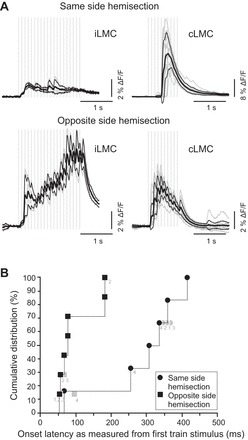Fig. 7.

Sawtooth responses may be the result of more faithful and direct transmission in the uncrossed pRS pathway. A: high-temporal-resolution recordings of population responses (large ROIs) evoked in iLMC and cLMC by stimulating the PRF on the same side (top row) or the opposite side (bottom row) of a cervical hemisection. Recordings for the 2 conditions were obtained from the same preparation after moving the electrode from 1 side of the brain stem to the other. Activation of the uncrossed pathway, but not the crossed pathway, produced sawtooth responses. For other details, see the legend for Fig. 4A. B: cumulative distributions of response latencies in iLMC (points unlabeled or marked with light gray label 1), iMMC (points marked with gray label 2), cMMC (points marked with light gray label 3), or cLMC (points marked with light gray label 4) on the same side of hemisection (solid black circles) and opposite side of hemisection (solid black squares) recording configurations. In 3 experiments, response latencies were measured in >1 motor column (indicated by light gray symbols). In all cases, the response latencies were included in the same cumulative distribution with the shortest 1 displayed with a solid black symbol. In the 1 experiment where the latency values in different motor columns were identical (due to finite temporal resolution of the recordings), the overlapping points were identified with light gray labels separated by a comma. The data clearly show that activation of the uncrossed pRS pathway produced shorter response latencies than activation of the crossed pRS pathway.
